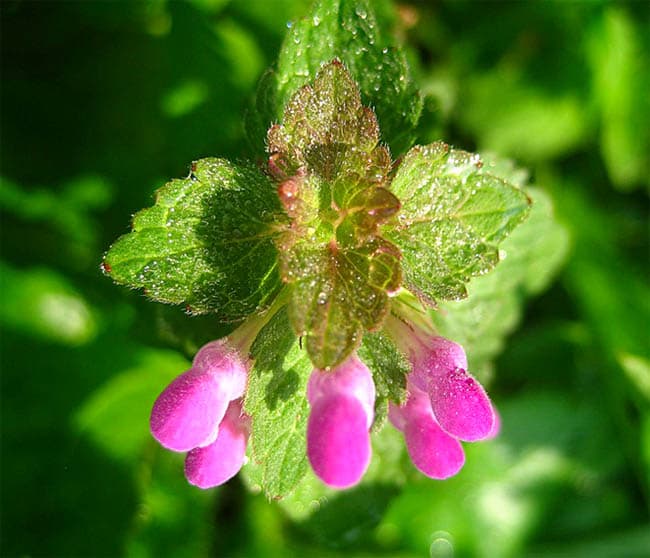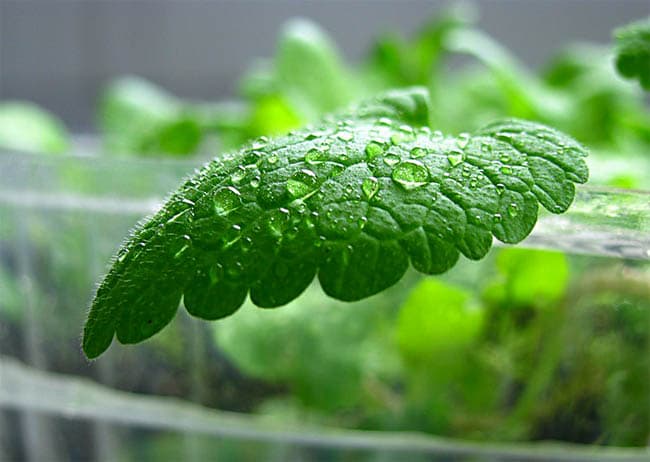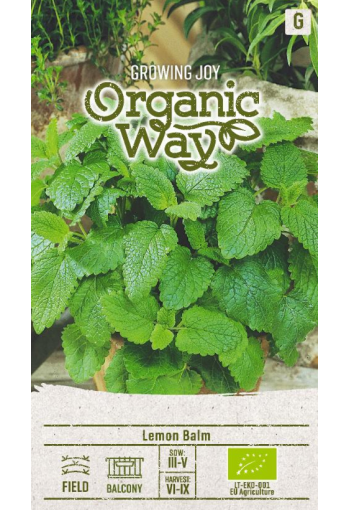Tonic plant with a lemon scent. Perennial spicy-flavouring heat-loving plant 100-120 cm is high.
Melissa lemon is an excellent honey plant, a popular spice and seasoning, as well as a medicinal plant that is used in medicine in the form of infusions and compresses, as a sedative for insomnia, neuralgia, asthma, and anaemia. As a diaphoretic and laxative. The plant is relatively cold-resistant, demanding fertility and soil moisture.
Melissa officinalis - Mediterranean forest plant. It has a light, pleasant aroma, which is why the name of this plant comes from the word "honey". It grows in a dense curtain, the stems are straight, branched, softly pubescent, up to 100 cm high. The leaves are simple, serrate, and light green. The flowers are whitish-pinkish, located in the axils of the leaves, open from July to August.
1,0 g = 1650 seeds.

Location: prefers a sunny location, but tolerates light shade.
Soil: planted in loose, well-drained, fertile soil.
Diseases and pests: practically not damaged.
Reproduction: lemon balm is propagated by seeds (sowing - in February, and in May, seedlings are planted in the ground) and dividing the bush. The bush is divided either at the beginning of May (the beginning of the growth of shoots) or at the end of August. The young plants are planted in a permanent place. Melissa grows quickly and blooms in the first year.
Use: its dense, strict bushes will decorate lightly shaded areas of the garden.
In addition, lemon balm is a very useful plant: its aroma improves mood, phytoncides purify the air, and flowers and leaves are an excellent medicine.

Common balm, lemon balm, balm mint, cure-all, dropsy plant, garden balm, melissa, sweet balm. Bot. syn.: Melissa cordifolia Pers.
* Continuation of summer in a home pot...
You can easily grow garden herbs at home, in a flower pot. It is enough to plant there, dug up from the garden (even from frozen ground) or brought from the basement, the “roots” of the same parsley, celery, and beets.
This technique is called “forcing” and has been known for a long time. The main problem in autumn-winter is the lack of light (the day is too short and there is not enough sun), which clearly interferes with the full development of plants - they grow too slowly and become very elongated.
What should do?
Install an additional illumination lamp directly above the “home garden”, or grow those plants that do not tend to stretch and are relatively resistant to lack of lighting.
Lemon balm is one of these plants. This spice is used as a fragrant additive to almost all dishes, especially borscht, boiled and fried potatoes, and tea. In addition to lemon balm, arugula can be successfully grown in the autumn-winter period, since its rapidly growing greenery is very juicy and has a pleasant piquant taste.
Fireweed tea with lemon balm.
Fireweed tea is brewed from the tops of fireweed, collected during the budding period and dried in the shade with the addition of lemon balm. To prepare the tea, pour 1 tbsp of a mixture of lemon balm and fireweed with a glass of boiling water and leave for 5-10 minutes.
Fireweed (Ivan-tea) - 1 part, lemon balm - 1 part.
Tea with lemon balm, St. John's wort and honey.
Chop St. John's wort, lemon balm and linden flowers. Pour boiling water over and let it brew for 3-5 minutes. Add honey.
Dried St. John's wort - 1 tsp, linden flowers - 1 tsp, dried lemon balm - 1 tsp, linden honey - 2 tsp.
Drink from lemon balm with honey.
Pour boiling water over the lemon balm leaves, cover tightly, let it brew for a few minutes and strain.
Pour 2 cups of lemon balm tea and beetroot juice into a bowl (boil the beetroot, finely grate, sprinkle with citric acid, pour in 0.5 cups of water, squeeze).
Add honey and a little vanilla sugar to the lemon syrup. Mix everything. If the drink is not sweet, add sugar or honey, if too sweet - citric acid.
Dried lemon balm - 2 tsp, beetroot juice - 0.5 cups, water - 2 cups, lemon syrup - 1 cup, honey - 0.5 cups, vanilla sugar - 1 packet, citric acid - to taste.
Honey liqueur with herbs.
In a saucepan, mix water, honey, all the spices and soda, boil the mixture over low heat for about 30 minutes, stirring and skimming off the foam. The heating temperature should not exceed +60 °C.
After the spicy-honey syrup has cooled, mix it with alcohol and pour into a glass container. Keep in a cool place for 2-3 days, strain, then filter and bottle. Keep the drink for at least two months, and ideally - 1-2 years. During this time, the liqueur will completely clear up, and a cloudy sediment will fall to the bottom.
The strength of the finished honey liqueur is about 40%.
Alcohol (96%) - 250 ml, honey - 250 ml, water - 250 ml, mint - 1 tbsp., lemon balm - 1 tbsp., thyme - 1 tbsp. l., St. John's wort - 1 sprig, soda - 0.5 tsp.
Melissa vodka.
Chop the lemon balm, mix with salt, place in a glass container, pour in vodka, close the container with a lid and leave for two days. Then strain, distill, pour into bottles and cork.
Melissa (dry herb) - 4 handfuls, salt - 1 handful, vodka - 12 l.











